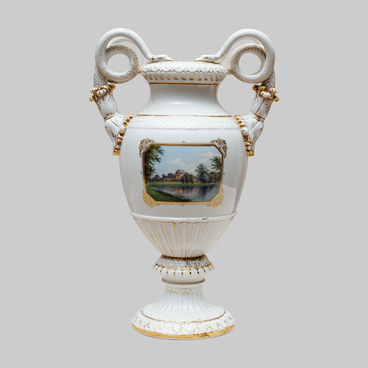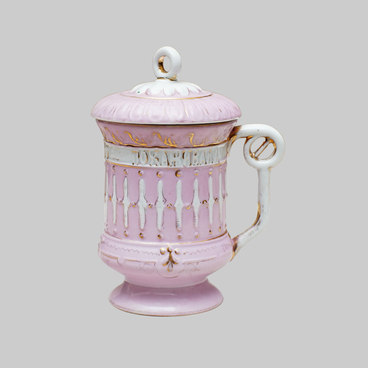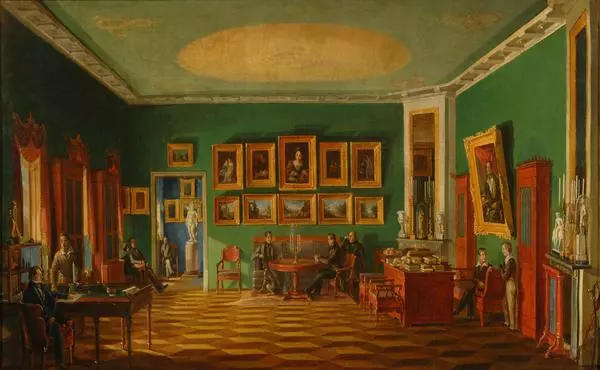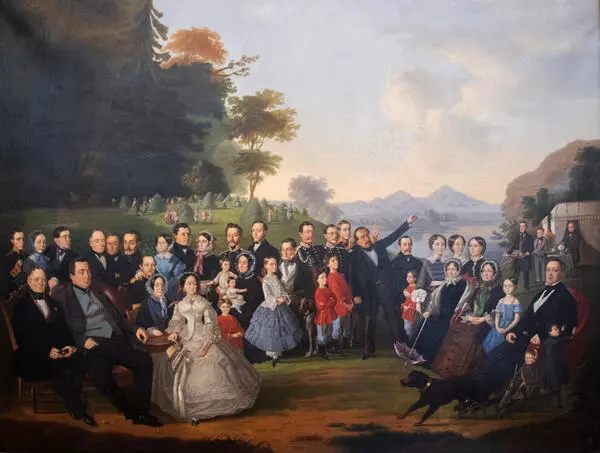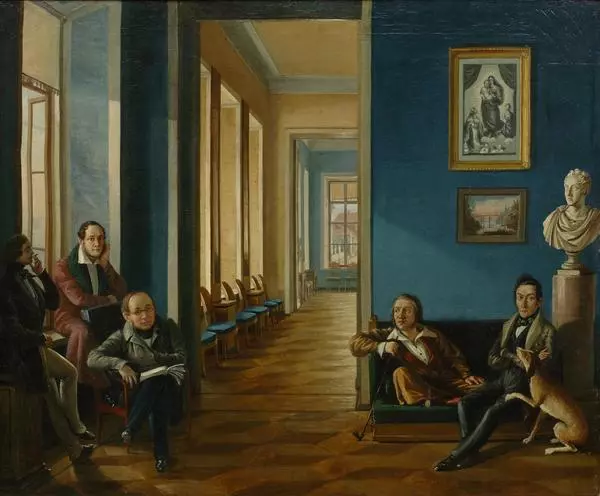The painting was submitted to the Ramenskoye Historical and Art Museum under the title “Interior view of the hall in the Denezhnikovo house”. It’s author was unknown at the time; the painting itself was dated 19th century.
The true name of the painting and the identity of its author were discovered in 1983. The painting ‘Interior view of the hall’ was displayed at the exhibition of Nikolai Podklyuchnikov in Ostankino. It turned out that a copy produced by the original painter around 1839 was kept in the museum all this time. In light of that discovery, the author’s identity could be ascertained. The painting was copied and lacked any marks on the reverse side of the canvas. The genealogy department of The Pushkin State Museum of Fine Arts has photographs of the painting exhibited here prior to its restoration. The inscription reads: “Count P. N. Zubov”s study in his mother”s house on Povarskaya Street in Moscow.”
The artwork is not only a traditional group portrait, typical of 19th-century manor painting but also a kind of “interior portrait.” Details of the interior paint a far more accurate picture of its owner than his own depiction.
On the reverse of the painting, there is another inscription. It reads: “'The interior of Platon Nikolaevich Zubov”s study in his home.' Persons depicted: Count Platon Nikolaevich Zubov, Princes Sergei Yakovlevich, Gruzinskiy, Alexandr Stepanovich Talyzin with his sons Stepan and Pyotr.”
The owner of the house, Count Platon Zubov, sits on the left of the sofa; Alexander Talyzin sits on the right. His sons, Stepan and Pyotr, stand beside the wall on the right. Prince Sergei Yakovlevich Gruzinsky (1795–1880), a descendant of the Georgian king Bakar Vakhtangovich Bagration-Gruzinsky, sits behind the desk.
The painting was created by Nikolai Podklyuchnikov. He was born into a family of serfs belonging to Count Sheremetev in 1813. Descended from the artistic family of Ivanovs-Shirokovs-Podkyuchnikovs. Nikolai’s family lived in Ostankino.
Since 1832, Podkyuchnikov attended the Art Lovers Club (also called the Natural Class) where three artists taught people their craft. Each member of the club pitched in to keep the club afloat. In 1833, the Natural Class was renamed the Moscow Art Class, and later —the Moscow School of Painting, Sculpture, and Architecture.
Podklyuchnikov’s earliest work, “View of the Ostankino Estate, ” is dated 1833. Six years later, Podklyuchnikov was supposed to receive the title of a free artist for his painting “View of the Church of St.Basil the Blessed in Moscow from the Moscow River”, but a serf could not claim such a title.
Nikolai was granted freedom in 1839 and moved to Moscow a year later. There, he continued to educate himself, participated in exhibitions of the Academy of Arts, and met collectors and art lovers.
Nikolai also took up the restoration of paintings around that time. The iconostasis of the Assumption Cathedral in the KrEmlin was his most significant restoration work.
Restoration sparked another passion in Podklyuchnikov: collecting artworks.
The true name of the painting and the identity of its author were discovered in 1983. The painting ‘Interior view of the hall’ was displayed at the exhibition of Nikolai Podklyuchnikov in Ostankino. It turned out that a copy produced by the original painter around 1839 was kept in the museum all this time. In light of that discovery, the author’s identity could be ascertained. The painting was copied and lacked any marks on the reverse side of the canvas. The genealogy department of The Pushkin State Museum of Fine Arts has photographs of the painting exhibited here prior to its restoration. The inscription reads: “Count P. N. Zubov”s study in his mother”s house on Povarskaya Street in Moscow.”
The artwork is not only a traditional group portrait, typical of 19th-century manor painting but also a kind of “interior portrait.” Details of the interior paint a far more accurate picture of its owner than his own depiction.
On the reverse of the painting, there is another inscription. It reads: “'The interior of Platon Nikolaevich Zubov”s study in his home.' Persons depicted: Count Platon Nikolaevich Zubov, Princes Sergei Yakovlevich, Gruzinskiy, Alexandr Stepanovich Talyzin with his sons Stepan and Pyotr.”
The owner of the house, Count Platon Zubov, sits on the left of the sofa; Alexander Talyzin sits on the right. His sons, Stepan and Pyotr, stand beside the wall on the right. Prince Sergei Yakovlevich Gruzinsky (1795–1880), a descendant of the Georgian king Bakar Vakhtangovich Bagration-Gruzinsky, sits behind the desk.
The painting was created by Nikolai Podklyuchnikov. He was born into a family of serfs belonging to Count Sheremetev in 1813. Descended from the artistic family of Ivanovs-Shirokovs-Podkyuchnikovs. Nikolai’s family lived in Ostankino.
Since 1832, Podkyuchnikov attended the Art Lovers Club (also called the Natural Class) where three artists taught people their craft. Each member of the club pitched in to keep the club afloat. In 1833, the Natural Class was renamed the Moscow Art Class, and later —the Moscow School of Painting, Sculpture, and Architecture.
Podklyuchnikov’s earliest work, “View of the Ostankino Estate, ” is dated 1833. Six years later, Podklyuchnikov was supposed to receive the title of a free artist for his painting “View of the Church of St.Basil the Blessed in Moscow from the Moscow River”, but a serf could not claim such a title.
Nikolai was granted freedom in 1839 and moved to Moscow a year later. There, he continued to educate himself, participated in exhibitions of the Academy of Arts, and met collectors and art lovers.
Nikolai also took up the restoration of paintings around that time. The iconostasis of the Assumption Cathedral in the KrEmlin was his most significant restoration work.
Restoration sparked another passion in Podklyuchnikov: collecting artworks.
